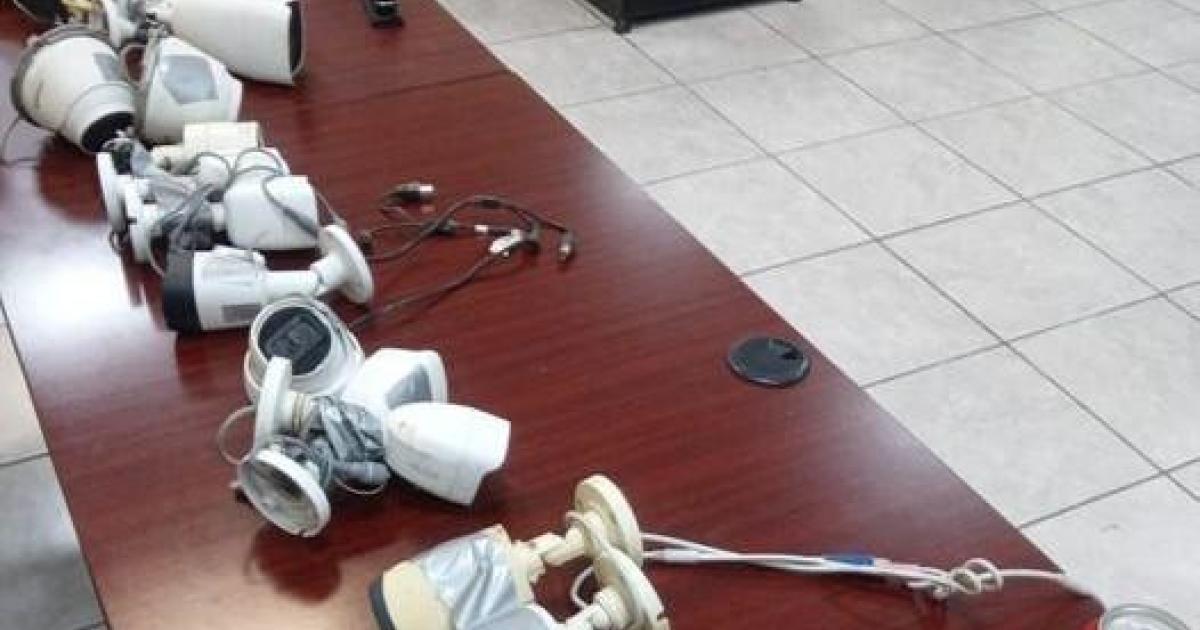Mexican authorities recently announced the discovery and removal of 24 drug cartel surveillance cameras strategically positioned throughout San Luis Rio Colorado, a border city situated across from Yuma, Arizona. These cameras, described as common porch-style cameras secured with duct tape, were mounted on various public infrastructure such as telephone poles, light posts, and even palm trees. This operation highlights the sophisticated surveillance tactics employed by drug cartels to monitor the movements of law enforcement and military personnel, underscoring the escalating conflict and technological advancements within the drug trade along the US-Mexico border. The seizure is not an isolated incident; similar sophisticated surveillance networks have been uncovered in other border towns, demonstrating a persistent and concerning trend. The cameras’ placement in multiple neighborhoods demonstrates the cartel’s efforts to maintain comprehensive situational awareness within the city. This extensive surveillance network enables cartels to anticipate and evade law enforcement actions, further complicating efforts to combat drug trafficking and related criminal activities in the region. The discovery underscores the ongoing challenges faced by authorities in maintaining security and controlling cartel activities along the US-Mexico border.
Sophisticated Surveillance Tactics Employed by Drug Cartels
Camera Placement and Technology
The discovery of 24 surveillance cameras in San Luis Rio Colorado reveals a sophisticated approach to intelligence gathering by drug cartels. The cameras, seemingly commonplace models, were strategically placed on public utility structures—telephone poles, light posts, and even palm trees—providing wide-ranging coverage across multiple neighborhoods. This demonstrates an understanding of urban infrastructure and the ability to seamlessly blend surveillance equipment into the environment, making detection difficult. The use of readily available, inconspicuous cameras highlights the cartels’ adaptability and resourcefulness. The simplicity of the setup, involving duct tape and readily available cameras, indicates a pragmatic approach to maximizing surveillance coverage with minimal risk of detection during installation. The dispersed locations of the cameras across three neighborhoods suggest a deliberate strategy to create a comprehensive surveillance network capable of monitoring a significant portion of the city. This strategic placement showcases the cartel’s detailed planning and execution capabilities.
Implications of Cartel Surveillance
The implications of such a comprehensive surveillance network extend beyond mere observation. Real-time monitoring of police and military movements allows cartels to anticipate raids, adjust their operations accordingly, and potentially plan ambushes. The data gathered also aids in identifying potential informants and vulnerabilities within law enforcement. This advanced level of intelligence gathering provides cartels with a significant advantage, making the task of combating drug trafficking exponentially more challenging for authorities. The network not only aids in evading law enforcement but also facilitates criminal operations such as drug smuggling and human trafficking, contributing to the overall insecurity in the region. The use of this technology allows the cartels to effectively map out the movement of law enforcement.
The Growing Threat of Cartel Surveillance in Border Cities
San Luis Rio Colorado’s Increased Vulnerability
San Luis Rio Colorado’s location on the US-Mexico border makes it a focal point for drug trafficking activities. The city’s history of violence between rival cartels highlights its increased vulnerability. While it’s known for inexpensive healthcare services attracting American visitors, the presence of cartel surveillance networks further complicates the city’s safety and security. This ongoing struggle for territorial control leads to a heightened security risk for both citizens and authorities. The deployment of surveillance cameras suggests that the cartels are increasing their efforts to monitor and control the area.
Precedent in Other Border Towns
The incident in San Luis Rio Colorado is not unique. Similar surveillance networks have been detected in other border cities, like Reynosa, Tamaulipas, in 2015, where a cartel operated a system of at least 39 cameras. This indicates a broader pattern of sophisticated surveillance strategies implemented by cartels along the US-Mexico border. The use of technological tools in monitoring and controlling territory illustrates a persistent issue across border towns. The fact that these sophisticated networks have been discovered in multiple cities indicates that this is not an isolated incident.
Combating Cartel Surveillance and its Impact
Challenges Faced by Law Enforcement
The discovery of these extensive surveillance systems underscores significant challenges faced by law enforcement in combating cartels. Neutralizing these networks requires coordinated efforts to identify, disable, and ultimately dismantle cartel surveillance capabilities. This involves technological expertise, intelligence gathering, and extensive cooperation between different law enforcement agencies on both sides of the border. Law enforcement agencies face difficulties in effectively monitoring the cartels’ evolving surveillance methods, especially with technology continually developing. Resources may be limited and finding those responsible for installing these cameras is no easy task.
The Importance of International Cooperation
Effectively addressing cartel surveillance necessitates international collaboration between Mexican and U.S. authorities. Sharing intelligence, coordinating enforcement efforts, and investing in joint technological solutions are crucial to dismantling these surveillance networks. Such collaboration includes sharing intelligence on technologies used by the cartels as well as on potential weaknesses in their security measures. Joint training exercises to prepare personnel for reacting to discoveries of surveillance infrastructure such as the one made in San Luis Rio Colorado. Cross-border cooperation is absolutely paramount to successfully combatting the sophisticated networks put into place by the cartels.
Take Away Points:
- Drug cartels utilize sophisticated surveillance techniques, including extensive camera networks, to monitor law enforcement and control territory.
- The discovery of these networks in multiple border cities highlights a persistent and widespread threat.
- Combating cartel surveillance requires advanced technological capabilities, intelligence sharing, and strong international collaboration.
- The situation emphasizes the need for enhanced security measures and improved cooperation between Mexican and U.S. authorities to disrupt cartel operations and ensure public safety.




